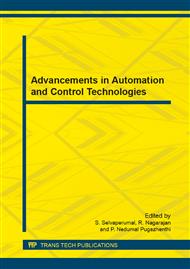[1]
J. Feng, A.K. Jain, and A. Ross, Detecting Altered Fingerprints, " Proc. 20th Int, l Conf. Pattern Recognition, pp.1622-1625, Aug. (2010).
DOI: 10.1109/icpr.2010.401
Google Scholar
[2]
H. Cummins, Attempts to Alter and Obliterate Finger-prints, J. Am. Inst. Criminal Law and Criminology, vol. 25, pp.982-991.
DOI: 10.2307/1134845
Google Scholar
[3]
J. Zhou and J. Gu, A Model Based Method for the computation of Fingerprints' Orientation Field, IEEE Trans. Image Processing, vol. 13, no. 6, pp.821-835, (2004).
DOI: 10.1109/tip.2003.822608
Google Scholar
[4]
E. Tabassi, C. Wilson, and C. Watson, Fingerprint Image Quality, NISTIR 7151, http: /fingerprint. nist. gov/NFIS/ ir_7151. pdf, Aug. (2004).
Google Scholar
[5]
Jianjiang Feng, A. K. Jain, A. Ross, Fingerprint Alteration, MSU Technical Report, MSU-CSE-09-30, Dec. (2009).
Google Scholar
[5]
Abraham A & Nath B, Designing Optimal Neuro-Fuzzy Systems for Intelligent Control, In proceedings of the Sixth International Conference on Control Automation Robotics Computer Vision, (ICARCV 2000), Singapore, December (2000).
Google Scholar
[6]
J. Zhou, F. Chen, and J. Gu, A Novel Algorithm for Detecting Singular Points from Fingerprint Images, IEEE PAMI, vol. 31, no. 7, p.1239–1250, (2009).
DOI: 10.1109/tpami.2008.188
Google Scholar
[7]
S. Wood, C. Wilson, Studies of Plain-to-Rolled Fingerprint Matching Using the NIST Algorithmic Test Bed (ATB), Technical Report NISTIR 7112, April 2004. http: /www. itl. nist. gov/iad/894. 03/pact/pact. html.
DOI: 10.6028/nist.ir.7112
Google Scholar
[8]
D. Maltoni, D. Maio, A. K. Jain, and S. Prabhakar, Handbook of Fingerprint Recognition (Second Edition). Springer-Verlag, (2009).
Google Scholar
[9]
J. C. Wu, C. Wilson, Nonparametric Analysis of Fingerprint Data, 7226, National Institute for Standard and Technology, (2005).
Google Scholar
[10]
International Organization for Standardization, ISO/IEC 19795-1 – Information technology - Biometric performance testing and reporting - Part 1: Principles and framework, (2006).
Google Scholar


